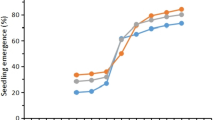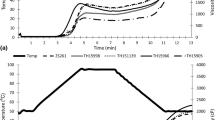Abstract
Four selections of three amaranth species were used in the study:A. cruentus (US Rodale 82S-1034),A. hypochondriacus (US Rodale 81S-1024).A. caudatus (Cusco, Peru CAC-2002) andA. cruentus (GUA-17). These were fertilized with levels of 0, 30, 60 and 90 kg/ha of a 12-24-12 fertilizer formulation applied to experimental plots 3×4m2 in four replications. The harvested grain was used for protein and fat analysis, and for protein quality evaluations on raw and on heat processed samples.A. cruentus (US) andA. hypochondriacus flowered at 43–44 days at 60 and 43cm, respectively,A. caudatus (Peru) at 51 days and 65cm, andA. cruentus (Gua) at 50 days and 80cm height. Days at harvest varied from 100 to 129 days at heights of 125 to 180cm. Yield of grain fromA. hypochondriacus (US) andA. cruentus (Gua) was higher than forA. cruentus (US) andA. caudatus, but did not differ for each pair. although not influencing yield, the application of fertilizer increased protein content forA. caudatus (Peru) from 12.35 to 14.50%; but not the protein content of the other selections. The fat content was affected differently in all four selections. The application of fertilizer did not affect protein quality either in raw or processed grain. On the other hand, processing increased protein quality, food intake, and animal performance significantly most clearly seen withA. cruentus (US) andA. caudatus (Peru) and to a lesser extent forA. hypochondriacus (US) andA. cruentus (Gua)). The data obtained showed inconsistent effects on yield and chemical composition, and no effect on protein quality with fertilizer application.
Similar content being viewed by others
References
AOAC (1975) Official Methods of Analysis of the AOAC. 12th edn. Washington, D.C.
Becker RE, Wheeler L, Lorenz K, Strafford AE, Grosjean OK, Bestchart MA, Saunders RM (1981) A compositional study of amaranth grain. J Food Sci 46:1175–1180
Bressani R (1983) Calidad proteínica de la semilla de amaranto cruda y procesada. Boletín No. 3 ‘El Amaranto y su Potencial’. Arch Latinoamer Nutr (Ed). INCAP, Guatemala.
Bressani R, Elías LG, González JM, Gómez Brenes R (1987) The chemical composition and protein quality of germ plasm amaranth in Guatemala. (To be submitted for publication) Arch Latinoamer Nutr
Carlsson R (1980) Quantity and quality of amaranth grain from plants in temperate, cold and hot, and subtropical climates. A review. Proc. 2nd Amaranth Conf. Emmaus, Pa
Cheeke PR, Bronson J (1980) Feeding trials with amaranthus grain, forage and leaf protein concentrates. Proc. 2nd Amaranth Conference. Emmaus, Pa.
García LA, Alfaro MA, Bressani R (1987) The digestibility and protein quality of raw and heat processed defatted and non-defatted flours prepared fromA. caudatus, A. cruentus andA. hypochondriacus. J Ag Food Chem (Submitted for publication)
Harris RS (1980) Effect of agricultural practices on the composition of foods. Part I. Effects of agricultural practices on foods of plant origin. Chapter 6. In: Harris RS, Karmas E (eds) Nutritional Evaluation of Food Processing. The AVI Publishing Co. Inc.
Hegsted DM, Mills RC, Elvehjem CA, Hart EB (1941) Choline in the nutrition of chicks. J Biol Chem 138:459–466
Imeri AG, Flores R, Elías LG, Bressani R (1987) Efecto del procesamiento sobre la calidad proteínica deAmaranthus caudatus. Arch Latinoamer Nutr (Submitted for publication)
Imeri AG, González JM, Flores R, Elías LG, Bressani R (1987) Variabilidad genética en rendimento, tamaño del grano, composición quimica y calidad proteínica de 25 variedades deAmaranthus caudatus. Arch Latinoamer Nutr (Submitted for publication)
Mendoza Montano CE, Bressani R (1987) Nutritional and functional characteristics of grain amaranth flour produced by extrusion cooking. J Ag Food Chem (Submitted for publication)
Manna L, Hauge SM (1953) J Biol Chem 202:91–96
National Research Council (1984) Amaranth Modern Prospects for an Ancient Crop. National Academy of Sciences. Washington, D.C.
Sánchez Marroquín A, Maya S, Pérez JL (1980) Agroindustrial potential of amaranth in Mexico. Proc. 2nd Amaranth Conference. Emmaus, Pa.
Saunders RM, Becker R (1983) Amaranthus. Vol. 6. Chapter 7. In: Pomeranz Y (ed) Advances in Cereal Science and Technology. American Association of Cereal Chemistry. St.Paul Minn.
Teutonico RA, Knorr D (1985) Amaranth. Composition, properties and applications of a rediscovered food crop. Food Tech 39:44–60
Trinidad A (1981) Efecto del nitrógeno, fósforo y densidad de población en el cultivo de la alegría. Colegio de Postgraduados, Centro de Edafología, Chapingo, México
Author information
Authors and Affiliations
Rights and permissions
About this article
Cite this article
Bressani, R., Gonzalez, J.M., Elias, L.G. et al. Effect of fertilizer application on the yield, protein and fat content, and protein quality of raw and cooked grain of three amaranth species. Plant Food Hum Nutr 37, 59–67 (1987). https://doi.org/10.1007/BF01092301
Received:
Issue Date:
DOI: https://doi.org/10.1007/BF01092301




